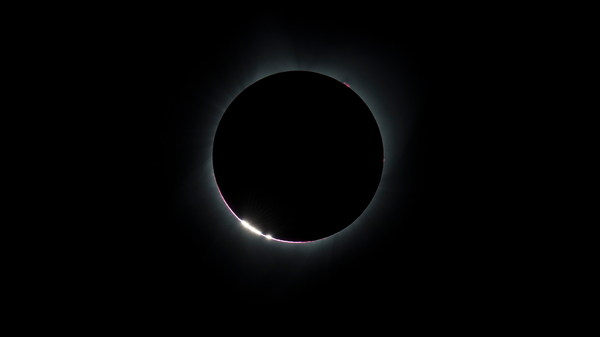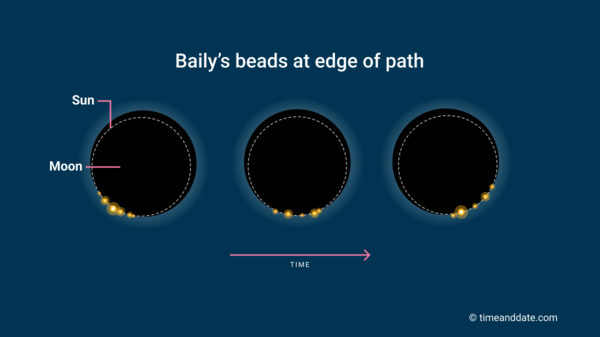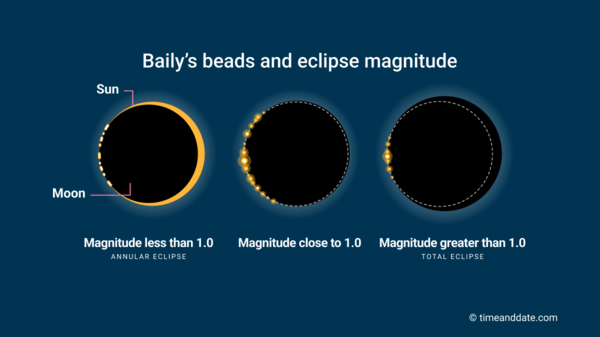What Are Baily’s Beads?
See the Sun shining through valleys along the edge of the Moon.

Baily’s beads appear in the seconds before and after the total or annular stages of a solar eclipse.
©NASA/Aubrey Gemignani
The Final Moments before Totality
A few seconds after the diamond ring forms during a total solar eclipse, the dazzling jewel of sunlight breaks up into points of light known as Baily’s beads. This string of bright beads is caused by the Sun shining through valleys along the edge of the Moon’s disk.
One by one, the beads quickly disappear as the Moon continues to move over the Sun. When the final bead of sunlight disappears, the total phase of the eclipse begins.
Baily’s beads and the diamond ring can also be seen, in reverse order, after the end of totality.
Baily’s Beads Also Feature in Annular Eclipses
During an annular eclipse, Baily’s beads (but not the diamond ring) can be seen in the moments before and after annularity.
But there is a difference. At a total solar eclipse, Baily’s beads appear along the leading edge of the Moon as it moves over the Sun at the start of totality. At the end of totality, they appear along the trailing egde.
For an annular eclipse, it is the other way round: the beads form along the Moon’s trailing edge at the start of annularity, and the leading edge at the end of annularity.
Watch a Replay of Baily’s Beads
The following video shows how the diamond ring and Baily’s Beads appeared before and after one minute of totality during the April 20, 2023, total solar eclipse in Australia.
How to See Baily’s Beads
IMPORTANT: A proper solar filter—such as eclipse glasses—MUST be used for looking at Baily’s beads and the diamond ring.
During a total solar eclipse, eclipse glasses should only be removed when the final Baily’s bead has disappeared, and the Sun is completely covered by the Moon.
Eclipse glasses should NEVER be removed when observing an annular eclipse, as the Moon never covers the Sun completely.
How to Photograph Baily’s Beads
To capture the diamond ring and Baily’s beads with a camera or video camera, a solar filter should not be used.
IMPORTANT: do NOT look at the Sun through the camera viewfinder before or during the diamond ring and Baily’s beads. The camera must be set up and adjusted in advance, using a solar filter.
The solar filter can be removed from the camera around 30 seconds before the diamond ring and Baily’s beads occur. Be careful when removing the filter, so as not to disturb the setup and alignment of the camera.
Why Are They Called Baily’s Beads?
Following a total solar eclipse across London in 1715, Edmund Halley (of Halley’s Comet fame) became the first astronomer to describe how the Sun breaks up into “stars” in the moments before totality. He wrote that this “could proceed from no other cause but the inequalities of the Moon’s surface.”
However, Baily’s beads are named after another astronomer, Francis Baily, who described them in more detail following an annular solar eclipse over Jedburgh, Scotland, in 1836.
Differing Durations of Baily’s Beads
The maximum phase of a total or annular solar eclipse is visible only along a narrow path of totality or path of annularity. Eclipse chasers generally prefer to be near the center of this path, because that is where totality lasts the longest.
The longest duration of Baily’s beads, on the other hand, is found at the edge of the path. Here, the Moon grazes the edge of the Sun’s disk, producing more beads of light.

Near the edge of the path of totality, observers see a shorter totality, but a longer duration of Baily’s beads.
©timeanddate
The magnitude of an eclipse also affects the number of Baily’s beads. For a total solar eclipse, a large magnitude—where the Moon is much bigger than the Sun—produces a longer totality. For an annular eclipse, a small magnitude produces a longer annularity.
But in both cases, a magnitude close to 1.0—where the Moon is roughly the same size as the Sun—results in more Baily’s beads.

An eclipse magnitude close to 1.0 produces a shorter totality or annularity—but more Baily’s beads.
©timeanddate
Did You Know?
Francis Baily was born on April 28, 1774. The total solar eclipse across North America on April 8, 2024, will mark—almost exactly—the 250th anniversary of his birth.